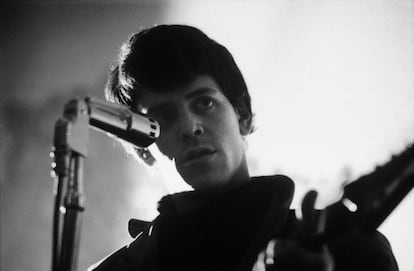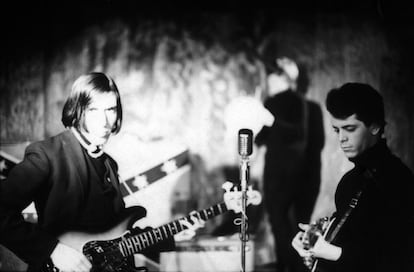Newly discovered demo tape showcases Lou Reed’s early recordings after suffering shock therapy at 17
A previously unreleased collection of the punk rock legend’s first recordings, including an acoustic version of ‘Heroin,’ shines light on his early experiments with songwriting after enduring electroconvulsive treatments as a teenager

Lou Reed was 17 when his parents, Toby and Sidney, took him to see a psychiatrist. They were worried about the boy’s mood swings and feminine tendencies. It was the late 1950s, and for a middle-class family of Jewish New Yorkers, the prospect of having a homosexual son was virtually inconceivable (in reality, Reed was bisexual). The psychiatrist wrote in a letter that the boy “suffered from delusions and hallucinations, saw spiders crawling on the walls… and might be schizophrenic.” According to Anthony DeCurtis’s account in his biography, Lou Reed: A Life, the future rock and roll icon framed the letter and hung it on his bedroom wall — a small, sardonic act of rebellion.
In the days that followed, Reed was subjected to electroshock therapy — a trauma that would mark the artist for the rest of his life. According to European journalist Ignacio Julià, an expert on Reed’s life and work and the author of the Spanish-language biography, Lou Reed: Catálogo irracional, “the trauma of those electroshock sessions has been well documented, and explains, in part, his artistic rage, his rejection of normality, his rebellious attitude towards the industry, and his antipathy towards journalists.” On September 16, a new collection of Reed’s early recordings will be released by Light in the Attic Records. The album, which consists entirely of previously unreleased home and demo recordings, is titled Word & Music 1965 (three of the album’s tracks are available now for preview), and it promises to open a new window into the early creations of that sour-faced, brilliant, traumatized young punk, whose early life in New York was as miserable as it was exhilarating.

The album shines new light on the artist’s formative years, before The Velvet Underground, when he was only 22 years old. Lou Reed (1942-2013) was always one step ahead of the pack. When he turned 16 and his peers started drinking, Reed was already smoking weed; when his friends were giggling at a Playboy they’d stolen from a magazine stand, Reed was reading the Marquis de Sade. He was drawn to dangerous writers: Burroughs, Vidal, Kerouac, Ginsberg — the Beat Generation. He liked to offend, to transgress, to be surrounded by dirty, shady, criminal things. To break taboos. To experiment and disobey. And then, to write songs about it.
When Reed enrolled at Syracuse University at the age of 18, he was undergoing treatment for depression. In his biography, DeCurtis describes Reed as an “experimenter”: if it involved sex, drugs, or music, he wanted to try it. According to some accounts, Reed started dealing heroin in college, and even employed his first serious girlfriend, Shelley Albin (to whom some of his most beautiful songs, such as “Pale Blue Eyes,” were dedicated) to make deliveries around campus. And of course, Reed used the drug himself as well.
In 1964, at the age of 21, Reed graduated with a degree in English Literature. He had cultivated a friendship with poet and short story writer Delmore Schwartz, Reed’s former teacher at Syracuse, who in addition to being a famous artist, was a drunk in the throes of creative decadence and mental illness. Reed adored Schwartz, listening to his alcohol-infused stories and aspiring to the excellence of his poems and prose — above all, the short story “In Dreams Begin Responsibilities,” which Reed considered a masterpiece. It was around that time that Reed found a job as a songwriter for the Long Island pop label Pickwick.
That was when Reed started experimenting with writing his own songs. One of the first was “Heroin.” Word & Music 1965 features this very first, and previously unreleased, recorded version of that song, which would later make it onto The Velvet Underground’s debut 1967 album, The Velvet Underground & Nico. In the early demo version, the vocals are rough and the guitar is acoustic, and the song only runs 3 minutes and 56 seconds, in contrast to the more than seven minute long electrified original. Reed tried to sell the song to his producers at Pickwick. “I was working for a record company as a songwriter,” he recalled in a later interview. “They’d lock me in a room and they’d say write ten surfing songs, ya know, and I wrote ‘Heroin’ and I said ‘Hey I got something for ya.’ They said, ‘Never gonna happen, never gonna happen.’” Reed recorded 11 original songs while working at Pickwick (all of which are on Word & Music 1965), including pieces that would later become part of The Velvet Underground’s renowned discography, like “Pale Blue Eyes” and “I’m Waiting for the Man.” All of these early recordings have an unmistakable vibe of 1960s Greenwich Village and the sounds of Bob Dylan, whom Reed adored.

“We could think of these demos as the missing link between the American folk tradition and the New York avant-garde,” says Spanish rock artist Christina Rosenvinge, a long-time admirer of Reed, who spoke with EL PAÍS about the release of Word & Music 1965. “Listening to ‘Heroin’ as a folk song is really incredible. Same with ‘I’m Waiting for the Man.’ With an arrangement like that you’d expect to be listening to lyrics about freight trains, women from faraway lands, fields, flocks of birds, etc. but instead you’re down in the Lower East Side — its own kind of wilderness — scrounging for your next fix. It’s a real clash of sensations. These recordings give us a brief glimpse of Reed when he was still searching, experimenting, just starting to collaborate with John Cale when Cale had barely started playing with La Monte Young’s band… It’s truly marvelous.”
Ignacio Julià, who also spoke with EL PAÍS about the new album release, describes 22-year-old Lou Reed as “a troubled young man driven by an intense passion for the underworld — the periphery of society, the people who lived on the margins — and for creating music that reflected this world and his experience in it.” Julià was “always impressed by the fact that Reed recorded his first album, a doo-wop single, when he was only 16 years old, and that he was active as a musician until his final days.” Julià continues: “If we track Reed’s trajectory from those first rehearsals and demos to his misunderstood but in my view extraordinary final album, “Lulu,” a collaboration with Metallica, we see the full dimensions of an inimitable musical creator who broke all kinds of aesthetic, literary, and moral borders.”
“My older brothers had some Lou Reed vinyls,” Christina Rosenvinge recalls. “I remember listening to them when I was 14 and being totally floored. I loved the songs on Transformer; I was drawn to the mystique of the live performance on Rock and Roll Animal (I hadn’t been to a live show yet); and then Berlin, with the drama of the story. But then on top of it all, that semi-spoken voice — velvety, fragile, deep —coming through the speakers like it he singing directly into your ear. It was, and still is, hypnotic.”

The songs collected in Word & Music 1965 were recorded by the 20-something Reed on a tape that he then sealed in an envelope — stamped and dated May 11, 1965 and signed by a notary —and then addressed to himself: Lewis Reed. It was customary for musicians to mail their recordings to themselves as a way of establishing copyright: a sealed and notarized package proved that the songs existed on a given date. Reed was apparently looking toward his future and wanted to ensure the compositions would always be his. Two months after recording the songs, in July 1965, Reed, Sterling Morrison, and John Cale started a band called The Velvet Underground. In December of that same year, drummer Maureen Tucker joined the group.
The envelope was discovered in Reed’s office in 2017, four years after his death, when his widow and fellow artist Laurie Anderson reached an agreement with the New York Public Library to donated a number of Reed’s belongings to the institution. The tape and all its recordings had remained hidden for 52 years — an apt coda to the life of an aloof and surly genius, who sang to the lost souls of the city better than anyone before or since.
Tu suscripción se está usando en otro dispositivo
¿Quieres añadir otro usuario a tu suscripción?
Si continúas leyendo en este dispositivo, no se podrá leer en el otro.
FlechaTu suscripción se está usando en otro dispositivo y solo puedes acceder a EL PAÍS desde un dispositivo a la vez.
Si quieres compartir tu cuenta, cambia tu suscripción a la modalidad Premium, así podrás añadir otro usuario. Cada uno accederá con su propia cuenta de email, lo que os permitirá personalizar vuestra experiencia en EL PAÍS.
¿Tienes una suscripción de empresa? Accede aquí para contratar más cuentas.
En el caso de no saber quién está usando tu cuenta, te recomendamos cambiar tu contraseña aquí.
Si decides continuar compartiendo tu cuenta, este mensaje se mostrará en tu dispositivo y en el de la otra persona que está usando tu cuenta de forma indefinida, afectando a tu experiencia de lectura. Puedes consultar aquí los términos y condiciones de la suscripción digital.
More information
Últimas noticias
Maduro pleads not guilty before the federal court in New York: ‘I am still the president of Venezuela’
A new test can detect Alzheimer’s from a finger prick
UN team enters Sudanese city of El Fasher after paramilitary massacre: ‘It’s like a ghost town’
A recipe for resistance: Indigenous peoples politicize their struggles from the kitchen
Most viewed
- Gilles Lipovetsky: ‘If you want to live better and fall in love, take Prozac, don’t look to philosophy’
- Alain Aspect, Nobel laureate in physics: ‘Einstein was so smart that he would have had to recognize quantum entanglement’
- Alvin Hellerstein, a 92-year-old judge appointed by Bill Clinton, to preside over Maduro’s trial in New York
- Why oil has been at the center of Venezuela-US conflicts for decades
- Maduro’s downfall puts China’s relationship with Venezuela to the test










































